
How the pressure cooker was invented

From authentic records, it has been established that the pressure cooker was invented by a French Physicist and Mathematician called Denis Papin. The first version of the pressure cooker was unveiled publicly in 1679; it was called the Steam Digester. Denis Papin discovered a way to design a vessel made from cast iron that had the features of a pot. He also developed a suitable lid for this vessel with features that ensured it could be tightly sealed when locked. Denis Papin was able to achieve a high boiling point when water was heated in this early version of the pressure cooker. At such a high-temperature tough foods and bones cooked in the vessel became remarkably softer after cooking for a short time. The new invention was promoted as a “New Digester” for use in the kitchen, confectionaries, chemical labs, and in breweries.

Using the first versions of the pressure cooker required a lot of effort. The users had to find a source of heat, usually a big burning furnace, and it was quite dangerous because of the hot steam generated while cooking. There were notable challenges in regulating the steam and temperature in the early versions of the pressure cooker. This led to the invention of a safety valve, Papin found a way to incorporate a safety valve in the newly invented digester. His efforts at inventing the pressure cooker were recognized by the Royal Society in 1680, and Denis Papin was offered a membership at the organization.
In a demonstration of his invention, Denis Papin cooked a meal with the pressure cooker. The audience at the performance were the members of the Royal Society and King Charles II, as well as other members of the aristocratic group. :
John Evelyn, a highly recognized Horticulturist, was present at the event. In his diary, John Evelyn noted that the supper prepared by Denis Papin revealed how the pressure cooker could be used to cook and soften the hardest bones found in beef and mutton. In his words, “the hardest bones of beef itself, and mutton were made as soft as cheese without water or other liquor, and less than eight ounces of coal.” From his descriptions, it was obvious that John Evelyn and many other guests were impressed with the outcome after using a pressure cooker.
Pressure Cooker History
By the year 1680, a revolution had begun in the kitchen, with the introduction of a new cooker that cooks faster and can make hard foods soft with minimal efforts. It was tagged the Marmite de Papin; others called the new pressure cooker the Papin Digester. The early versions were made from cast iron mostly, and they featured a well-crafted lid that locked securely with the use of a screw. The screw acted like a clamp to ensure the steam generated was retained in the vessel when in use. Food is placed in the pressure cooker with some liquid; the heat generates steam which increases the pressure in the cooker because the steam is trapped inside. This is how the food is cooked in a short time. However, the new invention faced some challenges; it was difficult to regulate the pressure generated inside the vessel and many pressure cookers at that time exploded. Another issue faced with the design was the difficulty in producing the vessels made from a single sheet of metal (the machine stamped pots). The early versions of the pressure cooker cracked under pressure because they were cast. These experiences gave other inventors an opportunity to improve the design for pressure cookers.
Magdeburg Hemispheres -A quest to discover a sealed vacuum for the pressure cooker led to the use of the Magdeburg Hemispheres. These are a pair of large copper hemispheres with similar rims that could be sealed firmly due to the pressure created in the vacuum. When placed together, the hemispheres could not be pulled apart by even horses. However, they were easily separated when the pressure is released, and air enters the vacuum.
The demonstration of how effective the Magdeburg hemispheres are was done in 1663 at the court of Friedrich Wilhelm I of Brandenburg in Berlin. The sides of both rims were coated with grease and sealed. A total of twenty-four horses were used for this experiment, but the spheres could not be separated until some air was introduced into the vacuum.
All around us, there is a significant pressure exerted by air. However, we do not really feel this pressure. The calculations show that a force of about 14.7 lbs. Per square inch is exerted by the air around us, depending on factors such as wind speed and the climatic conditions. In an experiment conducted by Otto von Gueicke, in 1654, it was shown that a vacuum pump could be used to remove the air from the space between two hemispheres measuring a two and a half diameter. The pressure generated between these hemispheres was stronger than many people expected and the horses used for the experiment could not pull them apart without much effort.
The outcome of this experiment revealed that a lot of pressure could be generated from forces in the atmosphere. After the measurements, it was discovered that the horses didn’t stand a chance to pull the two hemispheres apart after air was removed from the vacuum, but the separation could only be achieved with a force of about two tons. This was a significant discovery in science.
The records of Guericke’s experiments were documented and studied over the years. One of such studies is the research done by Robert Boyle and Robert Hooke who sought to design a more effective air pump. The result is what we know today as Boyle’s law; it states that- The volume of a sample of ideal gas is inversely proportional to its pressure.
Denis Papin was one of Boyle’s associates. He also studied the features of air and gas pressure, and the results were used to develop the steam release valve for his pressure cooker which reduced the chances of an explosion.
The first publications about the pressure cooker were printed in 1915. This was the first move to commercialize the pressure cooker which was later sold in Germany by 1939. The early commercial versions of the pressure cooker were made by the National Presto Industries; these versions were among the inventions exhibited at the New York World Fair to introduce the pressure cooker to a larger audience.
One of the peculiar features of the pressure cooker, the hissing sounds caused by escaping steam made many people wary about the product and its use in their homes. Their concerns were mostly about safety.
The evolution of pressure cookers
Over time smaller versions of the pressure cooker were designed for private use in homes. In the United States, during the Second World War, many manufacturing companies were converted into production facilities for weapons and tools needed for the war. Consequently, the production of pressure cookers was focused on developing vessels that could be used in different ways during the war.
Normal production of pressure cookers for private use resumed after the war. The market experienced a boom, which was also noticed in the production of other kitchen tools such as saucepans and regular pots. Regarding the pressure cookers, manufacturers developed different sizes and capacities of pressure cookers to capture the growing market for the product. Unfortunately, the increased commercialization of the pressure cooker had an impact on quality. Many of the products sold in the markets exploded due to faulty steam release valves and rims. This trend caused consumers to avoid using the pressure cooker for safety reasons. While the market plunged, a few manufacturers who remained dedicated to producing quality pressure cookers remained in the market and became popular brands.
After the Second World War, people tried to recover their old lifestyle. Eating habits were formed, and the need for faster cooking methods naturally promoted the demand for pressure cookers again. However, the market for the pressure cookers only picked up in the early 1970s due to massive campaigns about healthy eating and the need to reduce the intake of fried foods.
It is still possible to find the older versions of the pressure cooker on sale; however, you will not be able to use them. They are sold to collectors on e-commerce websites such as eBay and other similar sites. These are pressure cookers that didn’t sell in the markets because of their poor designs and other deficiencies that made them prone to explosion.
In the 1990s, a season marked as the years of baby boomers, a majority of this population discovered the convenience of using pressure cookers.
Canned foods and the pressure cookers
One of the industries that have been influenced by the use of pressure cookers is the canning industry. The process of canning foods was introduced as a means to preserve foods for longer periods. Canned foods could last longer and were suitable to match the lifestyle of many consumers. They could buy canned foods and keep them until the foods are consumed. Canned foods made it possible for people to buy meats and fish without fear of the foods spoiling.
The demand for canned foods subsequently compelled the manufacturers of these products to meet the consumers’ needs. The best solution was faster processes of cooking, and the pressure cooker was a good option to cook foods quickly. Manufacturers of canned foods adopted the use of pressure cookers to commercially cook foods such as meats and fish, which were canned and sold.
Early Use of pressure cookers in the US
In the United States, unique versions of the pressure cooker were developed. The inventors made pressure cookers with thermostats to regulate the temperature, and the vessels were made from aluminium. The pressure cookers were secured to the floors with bolts as an additional safety measure. This design was accomplished by Holcomb & Hoke, a reputable manufacturing company in the United States. However, the products were not readily accepted by consumers because they were sold at a very high price. Moreover, the average American family had domestic workers to cook their foods.
Over the years, the changes in lifestyle made more American families consider the use of pressure cookers and the products were also used in factories commercially.
The First Pressure Cooker Patents
In 1902, the first patents were granted for the pressure cooker. However, there were so many on-going projects being done to develop the pressure cooker and overcome the early challenges many users experienced, in particular improving the issue of safety. In the 1930s, a unique system was developed for cooking foods in transit. It was called the exhaust cooker. The cooker used pressure generated from the car’s exhaust, but this invention was not a huge success.
The Flex Seal Speed Cooker was invented by Alfred Vischler in 1938; he patented his design which was showcased at the New York City trade show. This design was advertised as the first alternative to cooking meals under pressure; it was expected that this invention would replace the canning process because it had the shape of a saucepan. While the Flex Seal Speed Cooker was a huge success, in a few years, the design had been copied by other manufacturers in the market.
Rising demand for pressure cookers in modern cities
Migration from rural areas to bigger cities promoted the introduction of pressure cookers in the modern world. The families who came to the big cities brought their pressure cookers to make their traditional homemade meals. Others who wanted to continue eating good meals made with pressure cookers compelled the big stores to buy and stock pressure cookers in their stores located in cities.
Many homes in America adopted the smaller pressure cookers made from cast aluminium. The main reason for the wide adoption of pressure cookers was the convenience it offered and versatile use.
In the hospitality industry, the pressure cooker was also used commercially by chefs in hotels and restaurants. Pressure cookers made it possible to cook a wide range of foods quickly to meet the guests’ needs.
With the use of pressure cookers, a majority of the foods that were previously thrown away could now be cooked and eaten with little efforts. These foods included bones and parts of pork or beef, as well as hard grains.
The use of pressure cookers has also been promoted by the publishing of special cookbooks written by notable chefs. The recipes in these cookbooks mainly feature foods that can be prepared with the pressure cookers. Learning about more recipes for foods cooked in these products gives the owners of the pressure cookers more options regarding meals they can cook and provide the needed nutrients for their families.
Development of modern pressure cooker designs across the world
The issues encountered by the manufacturers of pressure cookers in the US limited the production of these products and the market. It can be stated that the market witnessed a period of stagnancy; the manufacturers sought ways to improve the pressure cooker to make it more effective and safer while the consumers preferred to use the regular pans which were safer. However, in Europe, pressure cookers were still used frequently in homes. The markets for pressure cookers in Europe and Asia were promoted by the War Reparations Act which was introduced in the 1950s. This policy made it possible for inventors to access funds to explore the development of new designs for the pressure cooker. The outcome of the various research studies is the modern pressure cooker design we now see sold in markets under different brands.
The improvements made by manufacturers of pressure cookers in Europe and Asia include the invention of better and safer valve release systems, as well as safety features for the pressure release mechanisms. In America, the limitations in their efforts to develop better pressure cookers compelled American investors to import the new designs developed in Europe and Asia. The decision to import from other countries expanded the market for European and Asian manufacturers and also increased profits. On the other hand, the re-introduction of improved pressure cookers into the American market was a big success, and many families were happy to buy the products.
Some of the features that made the pressure cookers a highly demanded product in the market include, the fast cooking properties of a pressure cooker, it is economical regarding energy efficiency, and its versatile use in cooking a wide range of healthy foods.
Pressure cookers are also selling fast in parts of the world where prices of electricity and gas are high.
Impact of pressure cookers today

A majority of the pressure cooker brands we find in the market today have helpful features to increase the value they offer. These products are improved with multiple safety features and mechanisms that do not require any special skill before the product can be used. The pressure cookers have secured a unique space in the global markets. Pressure cookers have helped parents cope with their busy schedules and still prepare healthy meals for their families. These cookers are now widely advertised on different media. The introduction of technology has also been used to improve the features of pressure cookers; now we have the electric pressure cookers that function the same way using a different source of heat compared to older versions. Innovation has also been used to improve the features of the lids and the metals used in manufacturing the cookers to make them more economical and give quicker results.